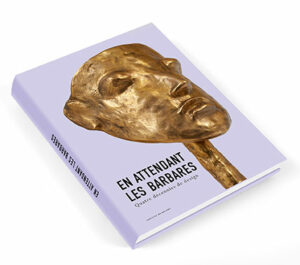The genesis :
At the start of the 1980s, the gallery En Attendant les Barbares began publishing two novice designers: Elizabeth Garouste and Mattia Bonetti. They take the name Garouste & Bonetti. Very quickly, their culture and their imagination gave them the triple status of designers, decorators and artists. Iconoclasts, Garouste & Bonetti inspire a new style, with an eclectic inspiration backed by perfect craftsmanship. Their first creations determine the bases of a new decorative current known as the “style barbare”. One of the characteristics of this style is to work with traditional craftsmen in traditional materials, like bronze, and to evoke multiple aesthetic and historical references.
The consecration :
This non-exhaustive approach allows Garouste & Bonetti to draw from multiple sources. Thus, they constantly renew their inspiration. The materials used are multiple: wrought iron, bronze, wood, patinated metal, parchment. The poetry of Garouste & Bonetti’s approach is reflected in the choice of names for their pieces. For example, Moon lamp, Mask lamp, Crown Box, Topkapi sofa, Isis table. In the tradition of French Decorative Arts, in the style of Jean Michel Frank, Garouste & Bonetti reintroduce the notion of bespoke. In the 90s, they imagined the concept of declinable lines. “Branches/Fourches”, “Olympiad”, “Leaves”, are all forms that adapt to different types of furniture. For example, a console can be transformed into a coffee table, a pedestal table into a dining room table, etc.
The separation of Garouste and Bonetti :
In the early 2000s, Garouste & Bonetti separated, leaving En Attendant les Barbares to continue publishing their creations. Their catalog is impressive. Some works have been exhibited in museums. These include the Center Pompidou, Museum of Decorative Arts (MAD), Victoria & Albert Museum (London), Grand Hornu (Brussels), Cartier Foundation, Guggenheim Museum (New York). Today, their rating with collectors makes them classics sought after by collectors, with some results reaching impressive heights, such as a wrought iron mirror, sold in 2013 at Sotheby’s for more than 103,000 euros. Among the craftsmen, it is worth mentioning Pierre Basse, the iron-smith of Diego Giacometti, who works exclusively for the gallery. Pierre Basse has developed unrivaled know-how, with specific hand-wrought iron work. In 1985, he contributed to the development of decorative elements by Diego Giacometti for the Picasso Museum. He also carries out appraisals of pieces by Diego Giacometti for prestigious auction houses, such as Christie’s and Sotheby’s.
Always halfway between art, design, and decorative art, the gallery calls on the bronzier Bocquel, who is the founder of Gérard Garouste, César, and Arman. It is he who creates the most sculptural pieces of Elizabeth Garouste.
The story continues :
After the separation of Elizabeth Garouste and Mattia Bonetti, the gallery still edits new pieces by them, each separately. First Elizabeth Garouste, to whom she has dedicated two personal exhibitions. Then Mattia Bonetti, who developed a brilliant international career. Eric Schmitt is also one of the early designers. He is still loyal to the gallery, which devoted its first personal exhibition to him in 1990. In 2020, he participated in the tribute exhibition “Diego Giacometti Forever”. On this occasion, he approaches the field of sculpture. He is also very present in the exhibition “Fantasmagories”, in 2022. The gallery publishes other design talents to whom it gives the opportunity to discover the know-how of exceptional craftsmen. Over time, Andrée Putman, Eric Jourdan (ArtParis Design Prize in 2013), Christian Ghion, Matt Sindall, and Arik Lévy have joined the gallery.
In 2009, during a personal exhibition, Andrée Putman, a longtime friend of Agnès Kentish, presented “les Boites d’Andrée” which developed and extrapolated the concept of the box. With elegance, it passes with ease from a bedside table with secret compartments to a sculptural desktop pencil holder from Macassar ebony to bronze to lacquer.
Between bespoke creations and limited series, the gallery En Attendant les Barbares abolishes the border between decorative art, art, and design. The aim is to create encounters between craftsmen and designers, the very essence of “collectible design”.
In 2022, the MAD (Museum of Decorative Arts) selected several pieces from the gallery for its “80s” exhibition. Some of these pieces are still produced, such as the classic Moon lamp by Garouste & Bonetti.

“En Attendant les Barbares,
Forty years of design”,
by Anne Bony,
Editions du Regard, 2022
152 pages, 45€
This large-format book is halfway between an art book and a design book. It traces the aesthetic adventure of the gallery, as the starting point of a decorative style, the “style barbare”, whose influence is still present and whose prices, in the auction rooms, continues to climb.
Anne Bony’s book goes beyond a simple story. The original artistic style, with its unexpected format, and sophisticated graphics, is more than a design book and reflects 40 years of creation. It is also a tribute to Irving Penn and Alexey Brodovitch.
Anne Bony is the reference design historian. She directs the famous collection of art books devoted to creation in the 20th century: The 10s, the 20s, the 30s, the 40s, the 50s, the 60s, the 70s, the 80s and the 90s. Also author of the books Furniture and Decor of the 40s, 60s, 70s and 80s.